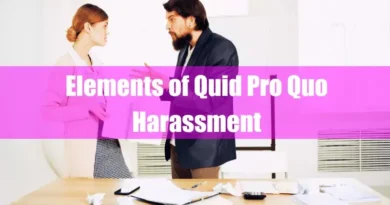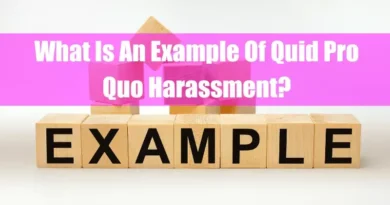Key Takeaways from the article “Explaining Gaslighting and Quid Pro Quo Relationship”:
- Gaslighting and quid pro quo harassment intertwine: Gaslighting, a tactic to distort reality and induce self-doubt, often merges with quid pro quo harassment, creating a particularly damaging dynamic. In these scenarios, perpetrators manipulate victims into doubting their perceptions and emotions while exploiting power imbalances for personal gain.
- Tactics of manipulation: Perpetrators of gaslighting and quid pro quo harassment employ various tactics, including memory manipulation, blame-shifting, invalidating feelings, recruiting allies, and instilling fear. These tactics erode victims’ confidence, isolate them, and perpetuate cycles of abuse.
- Recognizing red flags: Early identification of gaslighting and quid pro quo harassment is crucial. Signs include changes in behavior, constant self-doubt, dismissive responses to concerns, and inconsistencies in the perpetrator’s narratives. Awareness empowers individuals to resist manipulation and seek support.
- Resisting manipulation: Strategies to combat gaslighting and quid pro quo harassment involve trusting one’s intuition, documenting incidents, setting clear boundaries, prioritizing self-care, seeking support from trusted individuals and professionals, and knowing one’s rights.
- Creating supportive environments: Organizations and communities play a pivotal role in combating gaslighting and quid pro quo harassment by implementing zero-tolerance policies, providing education and training, fostering open communication channels, offering victim support, and promoting accountability.
- Empowering change: Healing from gaslighting and quid pro quo harassment requires collective efforts to raise awareness, challenge societal norms, hold perpetrators accountable, and empower victims. By fostering cultures of respect, empathy, and solidarity, we can create safer and healthier environments for everyone.
I. Introduction
Imagine this: someone makes you do something you’re uncomfortable with, then pretends it never happened, or worse, tells you it’s all in your head. That’s Gaslighting and Quid Pro Quo Harassment in a nutshell. It’s like a messed-up magic trick where your reality gets twisted for someone else’s gain.
Gaslighting? It’s like someone’s playing mind games with you, making you doubt what you heard or felt was real. They brush off inappropriate comments as jokes and accidents as nothing serious, leading you to question your sanity. On the other hand, quid pro quo pulls a “scratch my back, and I’ll scratch yours” but with stakes as high as your career. It’s about dangling the carrot of promotions or job security in exchange for favors you’re uncomfortable with. Combine the two, and you’re in a nightmare where your reality is twisted, and your career’s on the line, leaving you feeling trapped and powerless.

II. Tactics, Red Flags, and Power Plays in Gaslighting and Quid Pro Quo Harassment
Picture this: someone wants something from you, like a promotion or avoiding trouble. They dangle it like a carrot, then use sneaky tricks to bend you to their will. But there’s a dark twist – they twist your reality, too, making you question your own eyes and ears. That’s Gaslighting and Quid Pro Quo Harassment in action. Let’s break down the moves they use and how to spot them.
A. The Perpetrator’s Playbook:
- The Memory Eraser: “Did that even happen?” they say, wiping their hands clean of any wrongdoing. They might deny saying those creepy things, claim your discomfort was a misunderstanding, or even blame you for being “sensitive.” Suddenly, you’re questioning your own memory, wondering if you imagined it all.
- The Blame Game: It’s never their fault, oh no! They flip the script, making you the bad guy. Maybe you “misinterpreted” their intentions, “overreacted” to a joke, or even “provoked” them with your “attitude.” Now, you’re feeling guilty and confused, second-guessing your emotions.
- The Feeling Silencer: “Don’t be silly; that’s nothing to be upset about.” They brush off your feelings like crumbs off a tablecloth. Your anxieties? “Just overthinking.” Your discomfort? “All in your head.” By dismissing your emotions, they make you doubt your own judgment, silencing your inner voice.
- The Whispering Chorus: Sometimes, the gaslighting spreads. They recruit friends, colleagues, or even family to echo their twisted story, making you feel isolated and surrounded by doubt. It’s like a chorus of voices repeating, “It’s all in your head,” drowning out your own truth.
- The Fearmonger: They create an atmosphere of unease, where shadows lurk and threats hang heavy. They may hint at the consequences of speaking up, whisper rumors about your job being on the line, or build an environment of constant surveillance. Fear becomes your prison, keeping you trapped in their twisted game.
B. Red Flags: When the Dance Turns Dark:
- The U-Turn in You: Are you noticing changes in your behavior? Feeling less confident, questioning your decisions, or needing help to trust your gut? These are signs that gaslighting is taking its toll, chipping away at your self-worth and judgment.
- The Erosion of Trust: Do you isolate yourself, withdraw from loved ones, or lean heavily on the perpetrator for support? This emotional dependence can be a symptom of the manipulation, blurring the lines between trust and control.
- The Mind Maze: Foggy thinking, trouble concentrating, and difficulty making even simple decisions can be signs of mental distress caused by gaslighting. The constant questioning and confusion take a toll on your cognitive abilities.
- The Lonely Cage: Are you feeling isolated, disconnected from friends and family, or even fearing speaking up to anyone? This social isolation is often a deliberate tactic used by the perpetrator to keep you under their control.
C. The Power Play: Why They Dance This Way:
- Figures of Authority: Often, the perpetrator holds a position of power over you, like a boss, supervisor, or even a teacher. This hierarchical dynamic gives them leverage, making the quid pro quo threats and intimidation all the more potent.
- The Carrot and the Stick: They dangle rewards like promotions or approval, then threaten them away if you don’t comply. This keeps you trapped in a twisted game of cat and mouse, always chasing the carrot while fearing the stick.
- The Cycle of Silence: Gaslighting thrives in silence. The fear of consequences, the erosion of trust, and the isolation all work together to keep the victim quiet. This silence perpetuates the cycle of abuse, giving the perpetrator free rein to continue their manipulative dance.
Also, read,
- How to Create an Anti-Harassment Policy: 9 Effective Steps
- Clarifying Consent in Professional Environments
- Understanding Unwanted Advances
III. Resisting Gaslighting in Quid Pro Quo Harassment

When you’re caught in the dance of Gaslighting and Quid Pro Quo Harassment, finding your way out can feel impossible. The shadows twist your reality, the power imbalance suffocates, and the silence seems deafening. But remember, even in the darkest corners, there are tools to reclaim your light and rewrite your story. Here are some strategies to resist the manipulation and step back into the empowering sunshine:
A. Trusting Your Inner Compass:
- Validate Your Feelings: Don’t let anyone gaslight you out of your own emotions. Trust that gut feeling if something feels wrong, uncomfortable, or even dangerous. Your intuition is often your first line of defense.
- Document the Dance: Keep a record of events, interactions, and even specific words used by the perpetrator. This can be crucial evidence for seeking help or legal recourse. Remember, details matter, and notes or recordings can be powerful tools in reclaiming your truth.
- Seek a Safe Harbor: Confide in someone you trust – a friend, family member, therapist, or even a confidential hotline. Sharing your experience can break the isolation and provide invaluable support. Remember, you’re not alone in this dance.
B. Setting Boundaries, Defining Your Path:
- Speak Your Truth: Learn assertive communication skills to express your discomfort and refusal clearly and confidently. Practice setting boundaries and saying “no” without apology. You have the right to stand up for yourself and control your own interactions.
- Draw a line in the sand: Define clear limits of what you will and will not tolerate. Communicate these boundaries explicitly to the perpetrator and let them know the consequences of crossing them. This might involve reporting misconduct, seeking external support, or even legal action.
- Prioritize Yourself: In this dance of shadows, your well-being is paramount. Don’t prioritize the perpetrator’s demands over your own safety and mental health. Remove yourself from the situation, even if it means taking a difficult step, like quitting a job or ending a relationship. Your well-being is worth the cost of escape.
C. Seeking Support, Building Your Lifeline:
- Find Your Safe Haven: Connect with therapists or counselors specializing in trauma and abuse. They can help you understand the dynamics of gaslighting, process your experiences, and develop coping mechanisms. Professional help is not a sign of weakness but a powerful step towards healing and empowerment.
- Know Your Rights: Explore legal resources and advocacy groups specializing in harassment and abusive behavior. They can guide your options, from filing complaints to pursuing legal action. Knowledge is power, and understanding your rights can be vital in breaking free from the dance.
- Build Your Village: Surround yourself with a supportive community of friends, family, or even online support groups. These individuals can provide emotional validation, encouragement, and practical assistance as you navigate your recovery journey. Remember, you don’t have to fight this battle alone.
- 20 Quid Pro Quo Harassment Examples and How to Stop Them
- Quid Pro Quo Harassment vs. Hostile Work Environment Harassment
- Is Quid Pro Quo Illegal? 21 Accused Celebrities Examples
IV. Hypothetical Scenarios of Gaslighting in Quid Pro Quo Harassment
A. Examining Actual Cases of Gaslighting in Quid Pro Quo Harassment:
Gaslighting, a manipulative tactic that aims to distort reality and sow self-doubt, can often intertwine with quid pro quo harassment, creating a particularly insidious and damaging dynamic. Let’s explore some real-world examples across various settings:
1. Workplace Scenarios:
Supervisor withholds promotion. A female employee consistently meets or exceeds expectations but is denied a well-deserved promotion. Her supervisor subtly implies that her dress code is too “provocative” and suggests that “dressing for the part” might improve her chances. This leaves the employee questioning her own competence and attributing the missed promotion to her appearance rather than her qualifications.
Colleague sabotages work and takes credit. A coworker, envious of a colleague’s success, subtly undermines their work. They deliberately omit crucial information, miscommunicate deadlines, and then publicly take credit for the colleague’s accomplishments. When confronted, the gaslighter feigns confusion, claiming misunderstandings and accusing the colleague of being “overly sensitive.” This creates a hostile work environment and leaves the target questioning their own memory and perception.
2. Educational Settings:
Teacher pressures students for favors. A teacher offers students extra credit or academic assistance in exchange for favors, be it personal errands or inappropriate interactions. When the student hesitates or expresses discomfort, the teacher gaslights them, claiming to be “misunderstood” and suggesting the student is imagining things. This creates a power imbalance and leaves the student feeling trapped and vulnerable.
Coach manipulates athlete. A coach subtly belittles an athlete’s performance, implying they need to “prove themselves” more to earn playing time. If the athlete questions the coach’s criticism, they’re gaslighted with statements like, “I’m just pushing you to be your best,” and “Can’t you take a joke?” This erodes the athlete’s confidence and makes them question their own abilities.
3. Domestic Relationships:
Partner denies hurtful behavior. An intimate partner makes hurtful comments or engages in controlling behavior, then denies it ever happened when confronted. They gaslight the other partner by saying things like, “You’re being too sensitive” or “I never said that.” This creates a confusing and emotionally abusive environment, leaving the victim questioning their own sanity and reality.
Financial control used as manipulation. A partner manipulates their control over finances to exert power and influence. They might deny the victim access to funds, claim they’re “bad with money,” or gaslight them into believing they’re financially irresponsible. This isolates the victim, making them dependent and vulnerable to further abuse.
- Quid Pro Quo History Examples: A Complex Dance of Mutual Exchange
- Explaining Quid Pro Quo Harassment Under Title IX
B. Highlighting the Importance of Awareness and Education:
Combating gaslighting in quid pro quo harassment demands a multi-pronged approach that empowers individuals, fosters supportive environments, and holds perpetrators accountable. Let’s delve into each aspect:

1. Recognizing the Red Flags Early:
Gaslighting often creeps in subtly, leaving victims questioning their own reality. Be wary of these warning signs:
- Unexplained changes: Noticeable shifts in your work performance, academic grades, or usual behavior could be a red flag. Are you struggling to concentrate, withdrawing from social interactions, or experiencing unexplained anxiety? These might be signs of gaslighting’s insidious impact.
- Constant self-doubt: Do you constantly question your memory, judgment, or perception of events? Does someone frequently dismiss your concerns as “overreactions” or “misunderstandings”? This relentless undermining can erode your confidence and make you susceptible to manipulation.
- “You’re too sensitive” trap: Being met with dismissive phrases like “you’re too sensitive” or “Can’t you take a joke?” when expressing discomfort or concerns is a classic gaslighting tactic. It aims to silence your voice and make you question your own feelings.
- Inconsistent narratives: Pay attention to discrepancies in the perpetrator’s behavior or statements. Did they deny making a hurtful comment just minutes ago? Do their actions contradict their words? These inconsistencies can expose the manipulative nature of gaslighting.
2. Building Supportive Environments:
Creating safe spaces where gaslighting is not tolerated is crucial. Here’s how we can foster such environments:
- Zero tolerance policy: Implement clear policies against harassment and abuse in workplaces, educational institutions, and even personal relationships. Make it known that gaslighting will not be tolerated and will be met with appropriate consequences.
- Education and training: Equip individuals with the knowledge to recognize and report gaslighting. Training programs for employees, educators, and students can raise awareness and provide tools for identifying and addressing this form of abuse.
- Open communication channels: Establish safe and confidential channels for reporting concerns. Encourage open communication and empower individuals to speak up without fear of retaliation. Remember, bystander intervention can be crucial in disrupting gaslighting behavior.
- Victim support: Provide resources and support to those who have experienced gaslighting. This includes access to counseling, legal aid, and support groups to help them heal and reclaim their power.
Ultimate Bystander Intervention Training (BIT)
3. Promoting Accountability and Preventing Abuse:
Holding perpetrators accountable and preventing future occurrences is essential for lasting change:
- Disciplinary action: Ensure swift and appropriate disciplinary action against the perpetrator when identifying gaslighting. This clearly conveys that such behavior will not be tolerated and has real consequences.
- Bystander intervention: Encourage bystanders to speak up and interrupt gaslighting behavior when they witness it. This could involve directly confronting the perpetrator, supporting the victim, or reporting the incident to the appropriate authorities.
- Empowering individuals: Equip individuals with the tools and confidence to set healthy boundaries and say “no” to unreasonable demands. Assertiveness training and self-defense workshops can empower individuals to resist manipulation and protect themselves from further abuse.
Remember, gaslighting thrives in silence and secrecy. By raising awareness, creating supportive environments, and promoting accountability, we can shine a light on this manipulative tactic and empower individuals to reclaim their voices and build healthier relationships in all aspects of life. If you are experiencing gaslighting, reach out for help. You are not alone, and resources are available to support you on your journey towards healing and empowerment.
- 23 Emotional Effects of Quid Pro Quo Harassment.
- How to Report Quid Pro Quo Harassment.
- 13 Powerful Resources for Victims of Quid Pro Quo Harassment.
V. Conclusion: Stepping Out of the Shadows and into the Light

The shadows of gaslighting and quid pro quo harassment have loomed for too long, but the tides are turning. We’ve seen the insidious manipulation, the silencing of voices, and the devastating impact on individual lives. Now, it’s time to write a new narrative.
As individuals, organizations, and legal systems, we must join hands. Individuals can build self-awareness, speak their truth, and offer support. Organizations can establish clear policies, open communication channels, and provide training. Legal frameworks must adapt to recognize these abuses, while advocacy groups empower victims and hold perpetrators accountable.
Healing from gaslighting’s wounds is possible, but it takes a collective effort. By fostering a culture of respect, empowering voices, and holding perpetrators to light, we can build a future where everyone dances to their own rhythm, free from the shadows. We stand at the threshold of change – let’s step through together.
VI. Resources
A. Contact Information for Support Organizations and Hotlines:
- National Domestic Violence Hotline: 1-800-799-SAFE (7233)
- Rape, Abuse & Incest National Network (RAINN): 1-800-656-HOPE You can also get help online at RAINN’s website: https://www.rainn.org
- The National Sexual Assault Hotline: 1-800-656-HOPE. You can also get help online at RAINN’s website: https://www.rainn.org
- The Trevor Project: 1-866-488-7386. You can also get help online at The Trevor Project’s website: https://www.thetrevorproject.org.
- The National Suicide Prevention Lifeline: 988. You can also get help online at the National Suicide Prevention Lifeline’s website: https://suicidepreventionlifeline.org
B. Additional Resources for Further Learning and Exploration:
- The National Coalition Against Domestic Violence: https://ncadv.org
- The National Sexual Violence Resource Center: https://www.nsvrc.org
- The American Psychological Association: https://www.apa.org
- The National Center for PTSD: https://www.ptsd.va.gov
- The National Healthy Marriage Resource Center: https://healthymarriageinfo.org









